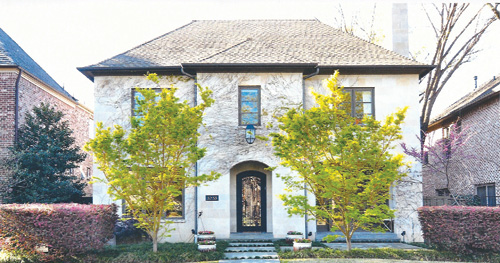By reducing expenses and a carbon footprint, downsizing can make sense and cents

Single dad Jon Langbert moved his 13-year-old triplets and pet Weimaraner, above, to an apartment in Addison from his Park Cities McMansion, opposite, in order to save money earmarked for tuition to the elite private schools his kids attend. (Arnold Wayne Jones/Dallas Voice)
JONANNA WIDNER | Contributing Writer
It’s always been the Dallas dream: A giant house in the midst of a sprawling central neighborhood, plenty of space for the kids, a game room and a suite for the in-laws, all topped with a nice big lawn (picket fence optional). And for a while, that’s exactly what Jon Langbert had.
“We were living in University Park, in a 4,600-square-foot home — what I’m sure people term McMansion,” says Langbert, single gay father to 13-year-old triplets. The house had four bedrooms, a game room with its own full bathroom, and six more bathrooms. “It was crazy-big,” Langbert confesses.
It may have seemed like the goal, but Langbert — as many LGBT Dallasites have done lately — chucked it. He packed up the house and kids and moved to Addison, to a new high rise apartment building called Fiori. Their new digs total just under 1,500 square feet, with just two bedrooms, a study and 2-1/2 baths.
“My son took the study as a bedroom,” Langbert explains, “he gets the half-bath, and uses the shower in my room in the morning.”
Langbert decided to make the transition after his girls were accepted into Hockaday, the well-respected, and expensive, private school in North Dallas. (Langbert was already paying for his son to attend another private school, St. Mark’s.) It didn’t make sense for the family to pay the sky-high taxes and living expenses that come with Park Cities if they weren’t going to take advantage of the primary benefit living there: The excellent public schools.
“The primary factor was the money,” Langbert says. “The girls were behind it because they knew the reason we wanted to cut costs was they were switching to private school. We went from roughly $10,000 to $3,000 a month in living expenses — the savings come out to roughly equivalent to three private school tuitions.”
But money wasn’t the only factor. A second benefit of the downsizing, he says, is the simplification of his lifestyle.
“As a single dad with three kids, it was a lot of work to keep up [with the old house],” he notes. “You feel like you’re either a full-time contractor or a full-time handyman.”
One would think those two benefits are enough, but Langbert soon figured out more.
“One thing that you can kind of feel good about yourself is that you can really reduce your carbon footprint. I didn’t think about it until I saw my first power bill, and I thought, ‘Well, this must just be for part of a month,’” he laughs. “No, it was actually for the whole month. You go from a few hundred dollars in a house that had gas as well for the cooking and hot water, to all-electric and still $70 per month for power, even in the deepest, coldest months. It really is efficient that way.”
The Fiori building is adjacent to Vitruvian Park, a greenspace with a small lake and ducks, which Langbert says he and his family also enjoy. The best part about it? He’s not required to mow it.
 “If you’re in a suburban subdivision with row houses, all that’s around is other houses, and you never see anybody,” he says. “Here, you go out and walk the dog, you see other people walking their dog, you get to say ‘Hi.’ You get to see your neighbors. It wasn’t like that in University Park. When I walked the dog, I never saw anyone out there. People come and go through their garages; in our case, in the garage you see other people.”
“If you’re in a suburban subdivision with row houses, all that’s around is other houses, and you never see anybody,” he says. “Here, you go out and walk the dog, you see other people walking their dog, you get to say ‘Hi.’ You get to see your neighbors. It wasn’t like that in University Park. When I walked the dog, I never saw anyone out there. People come and go through their garages; in our case, in the garage you see other people.”
Langbert also says getting out of The Bubble, where the speed limit is 30 mph everywhere, let him live life at a faster pace. With kids, that’s a bonus, as well.
Given the social aspects plus the savings, it’s no surprise that Langbert has noticed other Dallasites following a similar downsizing path. Of course, while his family ultimately loves it, there are naturally bound to be stumbling blocks.
“The hardest part,” he says, “has been convincing two 13-year-old girls to share a bathroom.”
This article appeared in the Dallas Voice print edition March 7, 2014.


